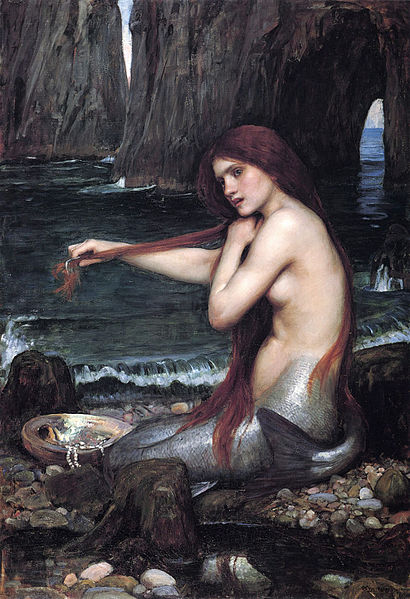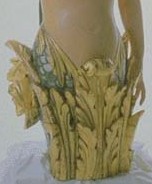For this post in “Go Figure!” I wanted to look at the two mermaids we have in our collection. For centuries myth and legends of mermaids have been told around the world, so I want to take this chance to share some stories and let you all know about the two ladies we have here in our collection.
The myth and folklore of mermaids have been around since 1000 B.C.E. While their whereabouts and intentions have differed through the years, this week I want to focus on the kinder and more gentle side of mermaids, since I think this particular figurehead has a sweet composure. For the next post, I will discus our other figurehead, and while she does not look the least bit frightening, I still think she is up to something.
Stories of mermaids have been around for centuries. In 1000 B.C.E in Syria, they were thought to be beautiful and loving women, similar to Greek mythology’s Aphrodite. In Syrian mythology the goddess Atargatis, went into the lake to become a fish, but the higher powers did not want to lose her body, thus making her half fish half female. More commonly recognizable is Homer’s epic, The Odyssey, features sirens, or beautiful nymphs that waded and sang in the water. While they did not have tails, they did fit a common belief of mermaids.

After doing some reading, I found that in Irish and Scottish folklore legend tells us that mermaids would wear a red cap, and if it were taken from them, they would then shed their scales to live with humans on land. This comes from a romantic background and the idea was also seen and the well known children’s movie, The Little Mermaid (I am still a fan so to say it’s a good movie for ALL ages).

Our first mermaid figure head was found in Bluebeard’s castle in St. Thomas and dates back to around the 1800’s. She is a three-quarter figure with gold leafing, silver scales and a shell atop her head. In 1935, the Mariners’ Museum acquired her from Bluebeard’s Castle, a 17th century castle in St. Thomas that now serves as a resort. This figurehead has a long history which began in Baltimore! The Vigilant, as it is now known, may have been originally named Nonsuch. In 1812, Nonsuch was purchased by the United States Navy in the War of 1812 for $15,000! The name was later changed to Vigilant and that is how she is known today. In the 1800’s she was charted by the Danish and then made her way to St. Thomas, which is where our figurehead was found.
As part of our collection, this first mermaid has been seen in magazines and books, probably due to her age and beauty. She was displayed in “Aqua” Circulation back in October and November of 1998. Also, David M. Hamilton used her in his book The Schooner Vigilant of St. Croix, with and image and mention of our museum! Most interesting was perhaps the way the U.S. Historical Society had a painting of the mermaid done inside of their Sail America Bowl! which were sold around the nation. Aside from magazines and bowls, our little mermaid traveled to the American Museum of Natural History in New York to be displayed in their Mythical Beasts exhibit in 2007.
The mermaid for next week is my favorite of the two, so make sure you check back to learn more about mermaids as creatures of evil and the story of the second mermaid in our collection.
For more information about mermaid folklore check out: http://www.gods-and-monsters.com/mermaid-mythology.html